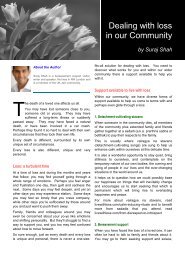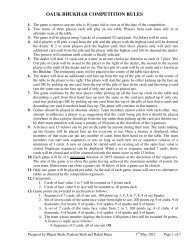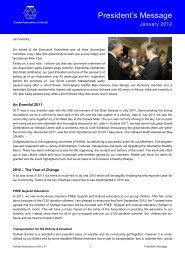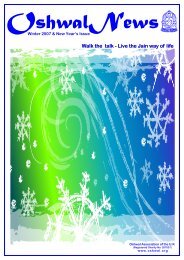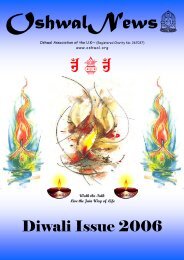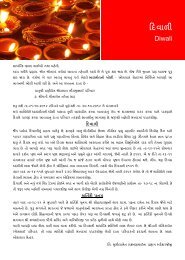Third Edition E-Magazine | April 2013 | www ... - Oshwal Centre
Third Edition E-Magazine | April 2013 | www ... - Oshwal Centre
Third Edition E-Magazine | April 2013 | www ... - Oshwal Centre
Create successful ePaper yourself
Turn your PDF publications into a flip-book with our unique Google optimized e-Paper software.
Whose planet are we living on?<br />
By Dr. Harshad N Sanghrajka<br />
The question: ‘Whose Planet?’ is very interesting<br />
indeed. It may be simpler from the mono-theistic<br />
philosophies to point the finger at God. But<br />
Jainism does not believe in a creator God. So the<br />
answer has to be different.<br />
First, I will try and explain the Jain perspective on<br />
environment. I claim that Lord Mahavir, the last Jain<br />
leader of this era, 599 BCE – 527 BCE, was our first<br />
environmentalist.<br />
His discourses on the following precepts support this<br />
claim:<br />
1. Ahimsa (Non-violence) – negation of violence in all<br />
forms<br />
2. Anekanta (Pluralism) – negation of singularity in<br />
opinions<br />
3. Aparigraha Altruistic (Attitude) – negation of<br />
accumulation<br />
Souls render service to one another; they create a<br />
common environment and live together in weal and woe.<br />
In other words, all life is interdependent.<br />
These precepts address the environment from both<br />
angles: social as well as ecological. This paper will be<br />
limited to the precepts and their relation to ecosystems.<br />
Eco is our natural surrounding in which earth, air, water<br />
and vegetation are in common ownership passed down<br />
from generation to generation. Eco cannot be isolated<br />
from life because LIFE is totally dependent on eco. We<br />
cannot imagine life in the absence of eco-friendly earth,<br />
air, water or vegetation.<br />
Scientists in modern times have been warning us about<br />
the protection of the environment and the results of<br />
ignoring it since 1900. But, Mahavir defined this<br />
phenomenon in the first scripture of the Jains called<br />
Acharanga Sutra which is extant and dated at 6th century<br />
BCE by academics.<br />
To relate AHIMSA to ecosystems, it is relevant here to<br />
understand the definition of the constituents of ecology as<br />
defined by Mahavir.<br />
Ernst Haeckel (1834 -1919), a German life-scientist,<br />
coined ecology by conjunction of the Greek words Oikos<br />
and Logos, which is now defined as the study of the<br />
relationships of organisms to their environment and to<br />
one another.<br />
In Indian tradition the five basic elements of nature: earth,<br />
water, fire, wind and space are defined as pancha mahaa<br />
bhoot ~ or five greater existents. These are so defined<br />
because the manifest universe arises from, subsists on,<br />
and disintegrates into these five elements.<br />
That organisms have relationship with one another was<br />
stated in the Jain work TATTVARTHA SUTRA from 2nd<br />
century CE and I quote aphorism 5.21:<br />
parasparopagraho jeevaanaam<br />
Mahavir classified four of these elements, excluding<br />
space, as sentient, as conscious, as capable of feeling.<br />
Thus, earth, water, air and fire are living organisms, not to<br />
be confused with other life which subsists within them.<br />
With plant life added to these four, Mahavir defined five<br />
individual life forms as one-sensed, immobile, living<br />
<strong>Oshwal</strong> News E-magazine of the O.A.U.K. 6 <strong>April</strong> <strong>2013</strong> <strong>Edition</strong>





